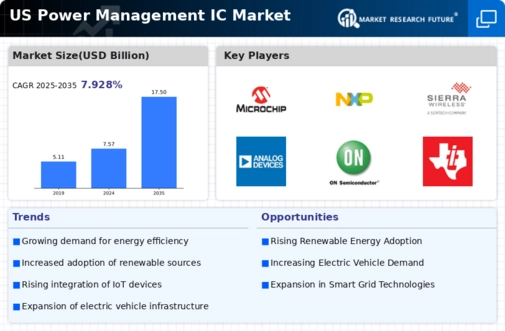Growth in Electric Vehicle Market
The power management-ic market is significantly influenced by the rapid growth of the electric vehicle (EV) market in the US. With the increasing focus on reducing carbon emissions, the demand for EVs is expected to rise sharply, leading to a projected market size of over $800 billion by 2027. This growth necessitates advanced power management-ic to manage battery systems, charging infrastructure, and energy distribution effectively. As automakers invest heavily in EV technology, the power management-ic market is likely to see a corresponding increase in demand for components that enhance battery performance and energy efficiency. The integration of power management-ic in EVs not only improves vehicle performance but also contributes to the overall sustainability goals of the automotive industry.
Rising Consumer Electronics Demand
The power management-ic market is experiencing growth driven by the rising demand for consumer electronics in the US. With the proliferation of smart devices, including smartphones, tablets, and wearables, the need for efficient power management solutions has become paramount. In 2025, the consumer electronics market is projected to reach approximately $400 billion, with power management-ic playing a critical role in enhancing battery life and performance. As manufacturers strive to create more energy-efficient products, the demand for advanced power management-ic is likely to increase. This trend indicates a shift towards more sustainable consumer electronics, where power management-ic solutions are essential for meeting consumer expectations for longer-lasting and more efficient devices.
Surge in Renewable Energy Adoption
The power management-ic market experiences a notable surge due to the increasing adoption of renewable energy sources in the US. As more solar and wind energy systems are integrated into the grid, the demand for efficient power management solutions rises. These systems require advanced power management-ic to optimize energy conversion and storage, ensuring that energy is utilized effectively. In 2025, the renewable energy sector is projected to account for approximately 30% of the total energy generation in the US, driving the need for innovative power management-ic solutions. This trend indicates a shift towards sustainable energy practices, which further propels the growth of the power management-ic market as manufacturers seek to develop products that enhance energy efficiency and reliability.
Increased Focus on Energy Regulations
The power management-ic market is significantly impacted by the increased focus on energy regulations in the US. Government initiatives aimed at promoting energy efficiency and reducing greenhouse gas emissions are driving the adoption of advanced power management solutions. Regulatory frameworks encourage manufacturers to develop products that comply with stringent energy standards, thereby enhancing the overall efficiency of electrical systems. As a result, the power management-ic market is likely to see a rise in demand for components that meet these regulatory requirements. This trend not only supports environmental goals but also fosters innovation within the industry, as companies seek to create compliant and efficient power management-ic solutions that align with evolving regulations.
Technological Advancements in Power Electronics
Technological advancements in power electronics are driving innovation within the power management-ic market. The development of new materials, such as silicon carbide (SiC) and gallium nitride (GaN), enables the production of more efficient and compact power management-ic solutions. These advancements allow for higher switching frequencies and reduced energy losses, which are crucial for applications in consumer electronics, industrial automation, and renewable energy systems. As the demand for high-performance power management-ic continues to grow, manufacturers are investing in research and development to create cutting-edge products that meet the evolving needs of various industries. This trend suggests a robust future for the power management-ic market as it adapts to the increasing complexity of power systems.























Leave a Comment